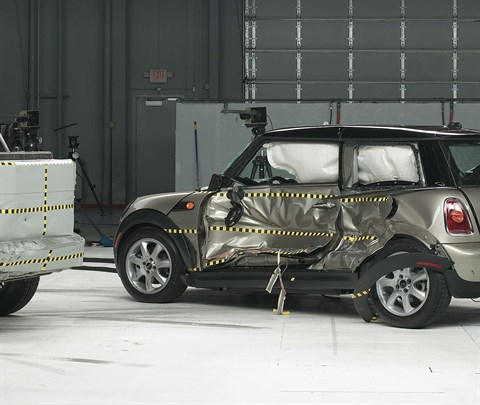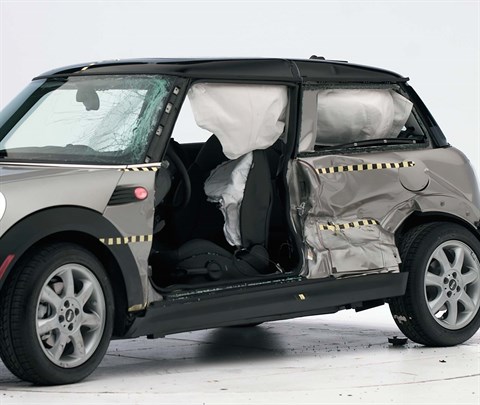Moderate overlap front: original test
Rating applies to 2007-13 models
Tested vehicle: 2007 Mini Cooper 2-door
The Mini Cooper was redesigned for the 2007 model year. Frontal ratings are assigned by the Institute based on a test conducted by BMW (manufacturer of the Mini).
| Evaluation criteria | Rating |
|---|---|
| Overall evaluation | |
| Structure and safety cage | |
| Driver injury measures | |
| Head/neck | |
| Chest | |
| Leg/foot, left | |
| Leg/foot, right | |
| Driver restraints and dummy kinematics | |
Side: original test
Rating applies to 2008-13 models built after July 2008
Tested vehicle: 2008 Mini Cooper 2-door with standard front and rear head curtain airbags and standard front seat-mounted torso airbags
The Mini Cooper was redesigned for the 2007 model year. Beginning with 2008 models manufactured after July 2008, changes were made to the side torso airbags to improve occupant protection in side impact crashes (note: information about when a specific vehicle was manufactured is on the certification label typically affixed to the car on or near the driver door).
| Evaluation criteria | Rating |
|---|---|
| Overall evaluation | |
| Structure and safety cage | |
| Driver injury measures | |
| Head/neck | |
| Torso | |
| Pelvis/leg | |
| Driver head protection | |
| Rear passenger injury measures | |
| Head/neck | |
| Torso | |
| Pelvis/leg | |
| Rear passenger head protection | |

View of the vehicle and barrier just after the crash test.

View of the vehicle after the crash with door removed, showing the side airbags and damage to the occupant compartment.

Smeared greasepaint shows where the driver dummy's head was protected from being hit by hard structures by the side airbags.

Smeared greasepaint shows where the rear passenger dummy’s head was protected by the side airbag.
Roof strength
Rating applies to 2007-13 models
Tested vehicle: 2009 Mini Cooper 2-door
| Overall evaluation | |
|---|---|
| Curb weight | 2,564 lbs |
| Peak force | 8,810 lbs |
| Strength-to-weight ratio | 3.44 |
Head restraints & seats
Seat type: Sport seats
| Overall evaluation | |
|---|---|
| Dynamic rating | |
| Seat/head restraint geometry |
About the head restraint & seat test
Currently, IIHS tests apply only to front seats.
